 |
 |
| Just after Thanksgiving, Scott & Linda Terrill found a White-winged Dove at Esplanade in Pacific Grove on 25 Nov (photo, right, © D. Roberson 26 Nov). This is a prime date for this southwestern vagrant; none have yet wintered in MTY. This one did not winter either. . |
|
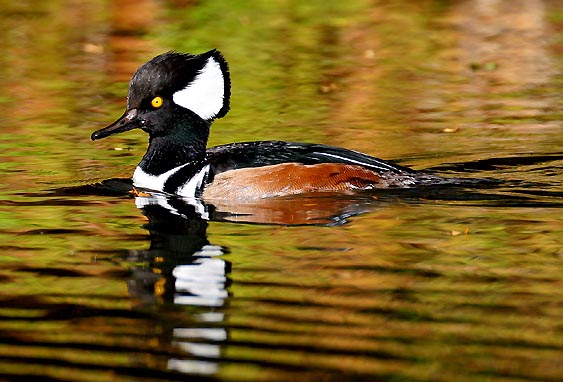 |
A Thanksgiving treat was this brilliant male Hooded Merganser near El Estero in Monterey (Pete Munter, photo 24 Nov © Blake Matheson). |
|
| The highlight of late October was this Brown Thrasher (right; © Bill Hill in yet another exceptional shot) at a birder's yard in the Carmel Highlands that is filled with bird feeders (Chris Hartzell). This is the 11th MTY record, and the 6th in fall, all between 12 Oct-29 Nov. The remaining records are of spring migrants (4) and one summering bird. This bird was at least 26 Oct-2 Nov. Birders chasing it also turned up two Clay-colored and a White-throated Sparrow and a Baltimore Oriole (Scott Terrill), a classic 'Patagonia Rest Stop' effect |
 |
 |
Meanwhile, in adjacent Santa Cruz County, a Crested Caracara has been present the entire autumn along Hwy 1 at Swanton Rd. This shot (left; © D. Roberson) was taken on 30 Oct about 3/4 mi up Swanton Road. The bird is an adult, and there is a very good chance it was the same bird present at this same locale in fall 2002. The bird was then molting out of juvenal plumage and had been initially found in MTY; see a separate web page on that 2002 occurrence. |
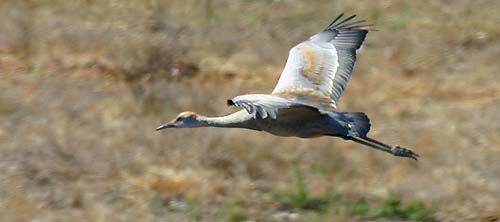 On
14 Oct, birders chasing the Vermilion were treated to an adult and young
Sandhill
Crane on Moro Cojo Slough, opposite the turnoff to Moonglow on Dolan
Road. This is the youngster — molting from juvenal to first-basic plumage
— in flight (right; © Blake Matheson). Throughout the period, Moonglow
continued to host a Cattle Egret (now known as "George" per Carol Calcagno),
and varying numbers of White-faced Ibis. On
14 Oct, birders chasing the Vermilion were treated to an adult and young
Sandhill
Crane on Moro Cojo Slough, opposite the turnoff to Moonglow on Dolan
Road. This is the youngster — molting from juvenal to first-basic plumage
— in flight (right; © Blake Matheson). Throughout the period, Moonglow
continued to host a Cattle Egret (now known as "George" per Carol Calcagno),
and varying numbers of White-faced Ibis. |
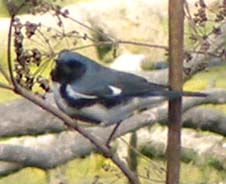 Other
major highlights from late September through mid-October were a male Painted
Bunting, briefly seen at Carmel River mouth 24 Sep (written details
from Lynn Hemink, also seen by Bev Brock); a Gray Catbird at the
corner of Acropolis & Shell in Pacific Grove on 5 Oct (sketch &
details by Don Roberson; far right); another Stilt Sandpiper near
Salinas in early October (Ryan Terrill +), and a male Black-throated
Blue Warbler at Moonglow Dairy on 12 Oct (photo © Brewster Young,
near right). Other
major highlights from late September through mid-October were a male Painted
Bunting, briefly seen at Carmel River mouth 24 Sep (written details
from Lynn Hemink, also seen by Bev Brock); a Gray Catbird at the
corner of Acropolis & Shell in Pacific Grove on 5 Oct (sketch &
details by Don Roberson; far right); another Stilt Sandpiper near
Salinas in early October (Ryan Terrill +), and a male Black-throated
Blue Warbler at Moonglow Dairy on 12 Oct (photo © Brewster Young,
near right). |
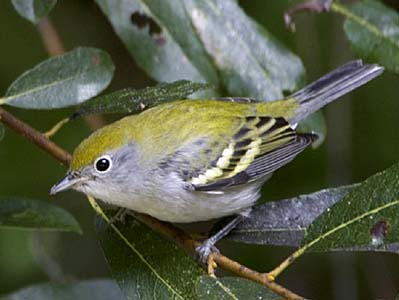 |
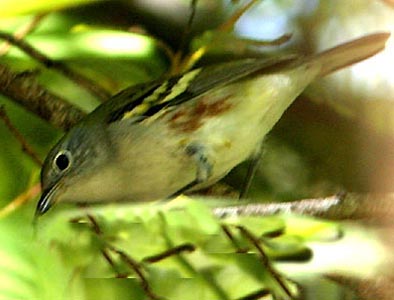 |
| The Carmel River mouth riparian heated up in late September. Here's a gallery of vagrant warblers there the first month of fall 2005: Chestnut-sided Warbler, imm female (above left 25 Sep; Bill Hill) & imm male (above right 1 Oct; D. Roberson); Blackpoll Warbler (left; 29 Sep, D. Roberson), Northern Waterthrush (below left 5 Sep; B. Hill), and Canada Warbler (imm female (below right 1 Oct; B. Hill). Canada is the rarest among this bunch, discovered on 1 Oct by David McIntyre for the 18th MTY record. The fall-out of Chestnut-sided Warblers was incredible: at least 10 different birds in the county between 2 Sep & 2 Oct. |
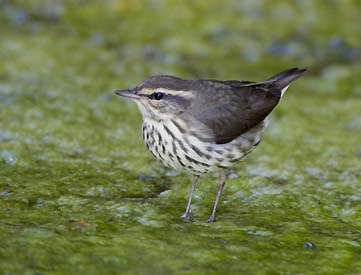 |
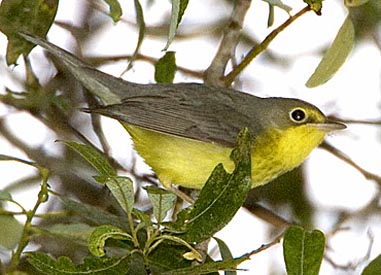 |
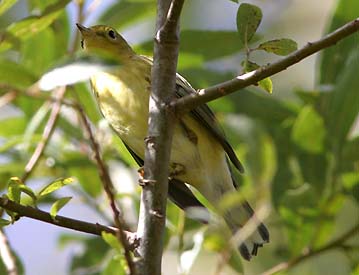 Fall
warbler season in early September featured a good showing of southwestern
vagrants, with at least 3 Lucy's and 2 Virginia's. A singing
male Hooded Warbler summered at Carmel R. mouth and was still singing
to early October. The best vagrant warbler to mid-month was a Prothonotary
at Esplanade in Pacific Grove 15-16 Sep (Blake Matheson, Tim Amaral). A
very odd "Yellow Warbler with wingbars," plus a white vent and tail spots,
puzzled many observers 5-15 Sep (photo below right; D. Roberson).
A discussion
of this bird was posted on the internet, leading to at least 3 experts
suggesting it could be a Yellow X Blackpoll or Bay-breasted hybrid,
a combination that has never before been documented. Fall
warbler season in early September featured a good showing of southwestern
vagrants, with at least 3 Lucy's and 2 Virginia's. A singing
male Hooded Warbler summered at Carmel R. mouth and was still singing
to early October. The best vagrant warbler to mid-month was a Prothonotary
at Esplanade in Pacific Grove 15-16 Sep (Blake Matheson, Tim Amaral). A
very odd "Yellow Warbler with wingbars," plus a white vent and tail spots,
puzzled many observers 5-15 Sep (photo below right; D. Roberson).
A discussion
of this bird was posted on the internet, leading to at least 3 experts
suggesting it could be a Yellow X Blackpoll or Bay-breasted hybrid,
a combination that has never before been documented. |
On 30 July, Carol Nichols and other kayakers discovered an adult Laughing
Gull near the Brown Pelican roost on Elkhorn Slough (below left; ©
Melinda Nakagawa). It then lingered for the rest of the summer and into
the fall, completing a pre-basic molt. By the time it was photographed
on 13 Sep (below right; © Peter Weber it had lost much of its black
hood. It was still present into November. Greg Meyer has commented that
it seems likely this is the same Laughing Gull that we first found on Elkhorn
Slough in late April, as he saw it again in May and June. Given its scarcity
locally (only 13 records), this seems a reasonable suggestion. Accordingly,
it appears this bird has been present locally for 7 months.
|
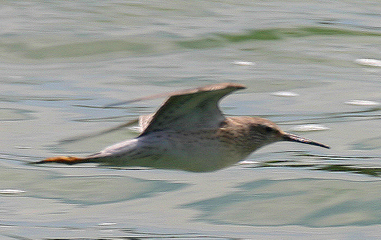
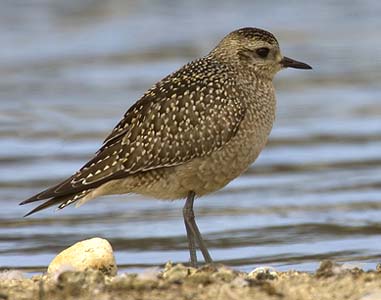 |
Fall shorebird migration was comparatively hum-drum. The numbers of Baird's and Pectorals were routine, as were the five juvenal Semipalmated Sandpipers. The most interesting waders were single juvenal Stilt Sandpipers at Salinas R. mouth 20 Aug (Ryan Terrill, David Vander Pluym) and near Salinas 21 Aug (flight shot, left, Blake Matheson); a juv. Ruff at Salinas 16 Sep (Rick Fournier), and a juv. American Golden-Plover at Carmel River SB 10-12 Sep (R.J. Adams; photo left Bill Hill). |
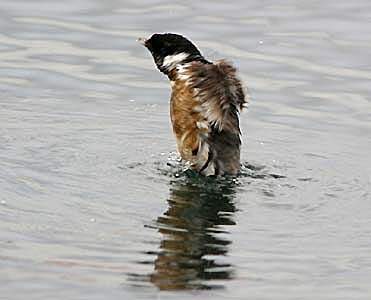 Pelagic
birds took center stage in August. One of two Ancient Murrelet found
by Richard Ternullo in July lingered inside Monterey harbor, actively chasing
small fish and delighting boatloads of birders. Alas, this individual was
oiled and likely flightless (right; photo D. Roberson on 14 Aug). Its remiges
are all missing or beat up. Whether it can survive with these disabilities
is not known. Pelagic
birds took center stage in August. One of two Ancient Murrelet found
by Richard Ternullo in July lingered inside Monterey harbor, actively chasing
small fish and delighting boatloads of birders. Alas, this individual was
oiled and likely flightless (right; photo D. Roberson on 14 Aug). Its remiges
are all missing or beat up. Whether it can survive with these disabilities
is not known.
A boat trip on 12 Aug had a young Short-tailed Albatross on Monterey Bay (Jeri Langham, D.L. Shearwater); photos by Don Doolittle are on-line elsewhere. It was banded; apparently a good percentage of the remaining population on Torishima Island (off Japan) have been banded. |
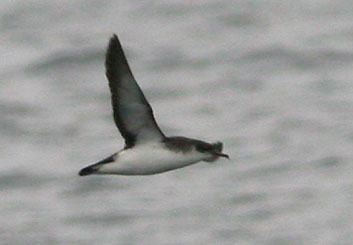 |
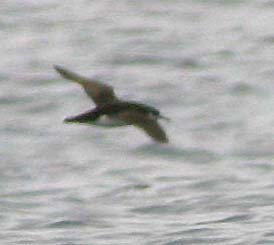 |
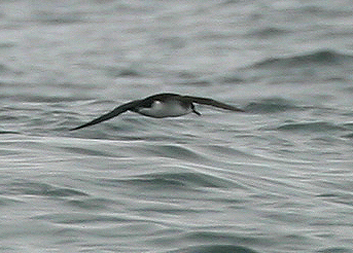 |
On 14 August, Todd Easterla spotted a Manx Shearwater ~5.5 nmi W of
Pt. Pinos. It was a brief fly-by, but quick shots by 3 photographers give
us a good handle on this bird. Note the white flank patch, the extensively
white underwings, and the 'ear-surround' pattern to the face.
Photos (clockwise from top left): Dan Singer, Don Roberson, Blake Matheson |
| Interestingly enough, word came this summer that an apparent nesting burrow of Manx Shearwater was discovered off Vancouver I., British Columbia. This new findings confirms my earlier comments, based on the regular spring and fall passage through California waters, that "this North Atlantic species apparently colonized the North Pacific in the early 1900s" (Roberson 2002; Monterey Birds, 2d ed., p. 92). The standard identification paper remains Roberson (1996) "Identifying Manx Shearwater in the northeastern Pacific," Birding 28: 18-33. |
| Another interesting observation on the 14 Aug pelagic trip was the discovery of Xantus's Murrelet youngsters that still had much natal downy feathers above (photo right; D. Roberson). These are "paired up" with an adult (probably the father) and, once the downy feathers are lost, the young will look like the adult. See further discussion of the implications of these observations elsewhere on this web site. | 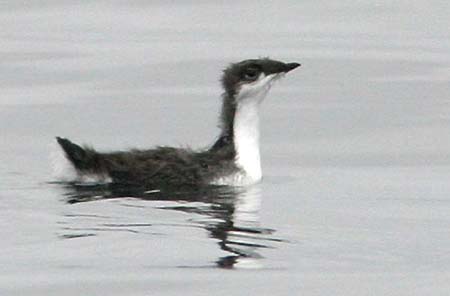 |
 |
|
|
|
|
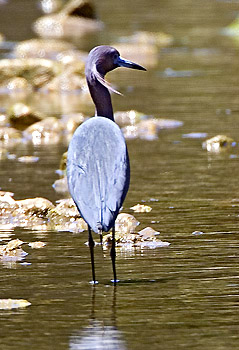 |
 |
|
OF FIRST HALF OF 2005 |